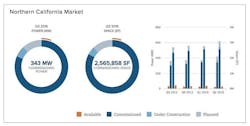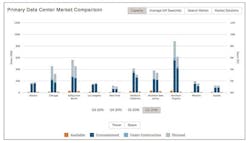We continue our series of stories on the leading geographic markets for data center space. Data Center Frontier is partnering with DatacenterHawk to provide in-depth market reports on each city we profile.
Silicon Valley is America’s leading engine of business innovation. It is also one of largest and most important data center markets in the U.S., providing space to deploy new hardware and services from the Valley’s marquee technology companies, as well as a legion of fast-moving startups.
Proximity to corporations and Internet consumers continues to be a key factor in where data centers are located. Silicon Valley provides one of the industry’s most compelling proximity stories. The region is home to America’s leading tech players, including Apple, Google, Facebook, Intel, Cisco, Oracle and many others. Its residents represent a huge base of tech-savvy consumers, who are consistently among the earliest adopters of new products and services.
Data Center Frontier Special Report: The Silicon Valley Data Center Market. Download It Now.
That’s why Silicon Valley remains one of America’s busiest markets for data center space, despite a number of potential deterrents, including expensive land, comparatively high cost of power, and the risk of earthquakes.
The Silicon Valley area is home to nearly 2.6 million square feet (SF) of commissioned data center space, representing 343 megawatts (MW) of commissioned power, according to market research from datacenterHawk. That makes Silicon Valley the second-largest market for data center space in the U.S., trailing only Northern Virginia.
Demand for space is strong, as reflected in the vacancy rate of just 8.2 percent in the region. The vacant space (approximately 26 MW) is scattered throughout retail colocation facilities in the Silicon Valley market. The wholesale data center market is very tight, with several operators working to deliver capacity.
Focus on Santa Clara
Much of the activity in Silicon Valley is focused on Santa Clara, which boasts 34 data centers located in a three-and-a-half square mile area, rivaling “Data Center Alley” in Northern Virginia for the world’s largest concentration of data centers. Santa Clara has emerged as the Data Center Capital of Silicon Valley due to competitive power pricing from the municipal utility, Silicon Valley Power, whose rates are significantly lower than the cost of power from PG&E in surrounding towns, with the price difference ranging between 25 and 40 percent.
This strong demand has paved the way for new construction, with Vantage Data Centers, Equinix and INFOMART Data Centers all planning expansions of their data center footprints in Silicon Valley.
A Legacy of innovation
Silicon Valley lies south of San Francisco extending roughly from Palo Alto southward to San Jose. It includes the Santa Clara Valley, which was once rich farmland but has emerged as fertile territory for technology innovation, including the silicon chips that gave the region its name.
The PAIX data center in Palo Alto (now Equinix SV8) is a key interconnection center dating to the early days of the Internet. (Photo: Rich Miller)
In the 1990s, the Valley’s tech companies focused on the Internet, creating a need for data facilities to house servers for web sites and applications. Early activity was concentrated in multi-tenant “carrier hotels” that housed dozens of service providers and web sites, including the Palo Alto Internet Exchange (PAIX) and the Market Post Tower in Downtown San Jose.
The dot-com boom helped define a new industry of colocation providers and hosting companies, who began building their own data center facilities around Silicon Valley.
Silicon Valley is the second-largest market for commissioned data center space in the U.S., trailing only Northern Virginia. Requirements typically originate from companies already located in the region, often representing the primary West Coast footprint for larger web infrastructures.
Strategic Imperative
In many cases, companies see data center space in Silicon Valley as a strategic imperative that outweighs other factors, similar to the attraction of Manhattan
or downtown Chicago.
Providers in Silicon Valley compete with several other markets. Hyperscale companies often weigh options in both Santa Clara and the Pacific Northwest, which offers cheaper land and power and a favorable climate for using outside air for cooling. It’s important to note that several cloud providers deploy capacity in both regions. Companies that are risk-sensitive may weigh options in Silicon Valley alongside providers in Phoenix or Las Vegas, which offer low disaster risk, or Sacramento, which offers a combination of lower earthquake risk and short driving time.
Here’s a look at datacenterHawk’s overview of the data center capacity, both present and future, in major U.S. markets.
For each market, the orange bar reflects available capacity, dark blue is commissioned space, light blue is space under construction, and gray is for planned
capacity. The first two bars in each grouping reflect capacity in power, while the second two represent space in square footage.
In terms of commissioned data center space (the dark blue bar), the top five markets are Northern Virginia, Silicon Valley, Dallas/Forth Worth, Northern New
Jersey and Chicago.
In our next article, we’ll take a closer look at supply and demand in the Silicon Valley data center market.
For more on the Silicon Valley market, we invite you to download the Data Center Frontier Special Report: The Silicon Valley Data Center Market.
About the Author







